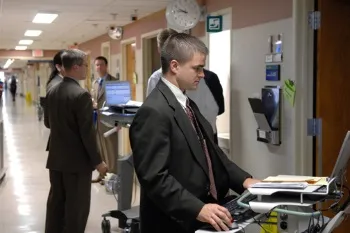Challenges in Health Care Delivery
In the early 2000s, there were several problems that Mayo doctor Nicholas LaRusso and the health care industry as a whole were facing.
First, they were becoming overwhelmed by administrative chores. An increasingly litigious society, new regulations concerning patient privacy, byzantine private and government insurance reimbursement systems, and the complexity of a highly specialized medical system meant that doctors were spending increasing amounts of time filling out forms and giving instructions to patients and colleagues.

Doctors in Hallway at Computer Stations
Second, doctors were coming under increasing cost pressures. In particular, because the government Medicare system of insurance for the elderly reimbursed providers at a level 20 to 50 percent below the cost of providing care, it was becoming difficult for clinics and hospitals to make ends meet. Doctors did not want to exclude Medicare patients, nor did they want to compromise on the quality of care given to them. This meant that it was urgent to increase efficiencies.
In addition, there were other overarching concerns. Because of changing patient behavior, the problems of obesity and diabetes were becoming increasingly serious, and Mayo was always looking for ways to improve preventive care and wellness.
Also, consumers were expecting higher levels of quality in a variety of settings, including health care. A number of service industries, including policing, schools, and airlines, had moved toward “data-driven” methods in which they closely monitored their processes for anomalies; the result was more efficient systems with fewer errors. But in medicine, the service infrastructure had changed little since the 1950s. New drugs and devices meant that Americans were living longer and healthier lives than ever before, but the health care experience had become complex and confusing. All of these developments meant that there were opportunities for improvements in the delivery of health care.